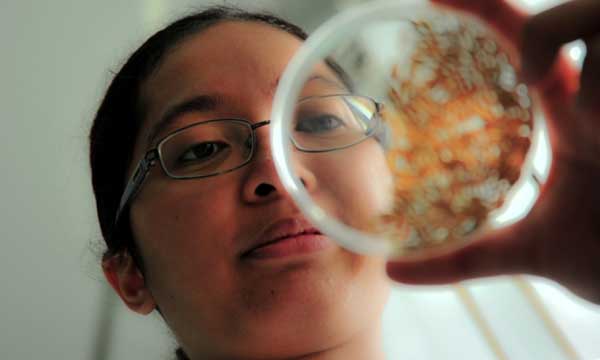
July is National Nutrition Month every year in the Philippines. This year’s theme is Together we can end hunger and malnutrition. To help kick off this important event, Rice Today is featuring rice nutrition and quality, not just where it pertains to the Philippines but to the rest of the rice-eating world as well. The importance of rice in relation to improving human health cannot be overemphasized as more than three billion people in the world eat rice every day.
When we talk about the merits of rice with those who are diet conscious, chances are the arguments will be split between those who think rice is healthy and those who advise keeping rice dishes at bay. But, what’s the truth? Our cover story on rice and nutrition, beginning on page 11, sheds light on how rice can be part of a healthy diet.
Recent media reports about arsenic and lead contamination of rice also have some consumers asking, “Is it still safe to eat rice?” Dr. Sarah Beebout, soil chemist at the International Rice Research Institute (IRRI), answers the question with a clear and succinct Yes in her Grain of truth contribution, Rice, health, and toxic metals.
Speaking of rice consumers, a story, In search of a perfect grain, looks into how IRRI scientists are studying the traits of rice grains to produce a higher-quality product more acceptable to consumers. They are contributing their expertise to ensure consumers get the type of rice they enjoy eating and help farmers benefit from the increased commercial value of high-quality rice varieties.
On other topical fronts, rice farmers in Bangladesh’s southwestern coastal region are still struggling to catch up with the productivity of the rest of the country. Thankfully, they are getting some much needed help to tackle water and salinity problems and optimize crop and fish production. (See Catching up in southwestern Bangladesh.)
The Africa Rice Center is carrying out a 3-year project to determine what diseases of rice exist, where and when they occur, and if climate change has any effects on their severity. Eventually, this project will develop rice varieties that are resistant to strains of blast and bacterial leaf blight, and concomitant management practices. (See Decoding patterns of climate change and rice diseases.)
What happens when a diverse array of rice scientists steps into a field to actually grow a crop of rice? Twenty IRRI staff members took on the challenge—a first for many of them—to compete for the highest yield and profit from a rice crop that they grew themselves, start to finish! Read some interesting anecdotes and lessons learned in Rice Survivor: IRRI’s own reality show.
Our map feature, A year in the life of rice, zooms in on how major rice-growing areas change during the wet and dry season on the island of Luzon, Philippines—an interesting and revealing 12-month cycle.
In his Rice facts column, Sam Mohanty points out that India and China are forces to reckon with and could be real Game changers in the global market. He says that, if the current trend continues, India will likely become the world’s top rice exporter and China the top importer by the end of 2013.
As food for thought, a Liberian rice fable, Give me some more, tells how rice mythically saved the Vai people, and how kolo, their word for rice, came to be.
Also, read the story behind the story in Rice Today and Uruguay’s President. This is a great follow-up on President José Mujica getting hold of a Rice Today article, Uruguay: a small country, big in rice, which had been translated into Spanish, and reading it, from start to finish, during one of his national radio addresses.
And finally, visualize a world 50 years from now in which rice farmers are no longer poor and hungry. Fields of plenty transports you to an imaginary, but very possible farming household in 2063. Here, an Indian lady farmer is running a profitable and environmentally friendly rice farm, thanks to new tools and technology that emanated from research being done by IRRI and its partners in 2013.
We’d love to hear from you on our choice of stories in this and other recent issues. Happy reading!
Lanie Reyes
Rice Today managing editor








